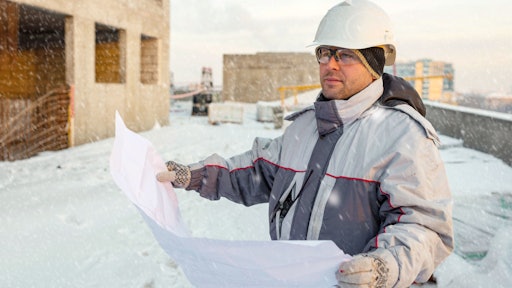
Calcium chloride is the most effective and least expensive cold weather accelerator for concrete. But its use may be limited by building codes or prohibited by some specifications. Contractors then have to ask one or two questions:
- Can we use calcium chloride admixtures?
- If so, what is an acceptable dosage?
Fortunately, the International Building Code (IBC) can be used to answer these questions.
ACI durability requirements incorporated in the IBC
ACI 318-11 “Building Code Requirements for Structural Concrete” contains provisions for the maximum allowable amount of chlorides in concrete. But ACI 318 does not govern design and construction of slabs-on-ground unless the slab transmits vertical loads or lateral forces from other portions of the structure to the soil. In accordance with Section 1904 of the 2012 IBC, however, concrete slabs-on-ground must comply with the Chapter 4 Durability Requirements of ACI 318-11.
Thus ACI 318-11 Chapter 4 can be used to determine when and how much calcium chloride can be added to a concrete slab-on-grade.
ACI exclusions for calcium chloride
For prestressed concrete or concrete containing embedded aluminum, ACI 318 does not permit use of calcium chloride or admixtures containing chloride from sources other than impurities in admixture ingredients. Thus contractors can’t use calcium chloride for post-tensioned concrete slabs-on-ground or slabs containing aluminum conduit or other aluminum embedments.
ACI exposure categories and classes
Table 4.2.1 in ACI 318-11 describes the following four exposure categories that affect the requirements for concrete to ensure adequate durability:
- F – freezing and thawing
- S – sulfate
- P – requiring low permeability
- C – corrosion protection of reinforcement
Exposure Category C addresses chloride content limitations. This category is subdivided into three exposure classes defined by the following conditions:
C0 – concrete dry or protected from moisture.
C1 – concrete exposed to moisture but not to external sources of chlorides.
C2 – concrete exposed to moisture and an external source of chlorides from deicing chemicals, salt, brackish water, seawater, or spray from these sources.
Interior slabs-on-ground are usually assigned to Class C0 because they are expected to be dry and protected from moisture in service. Exterior slabs-on-ground are assigned to Class C1 unless they would be subjected to deicing chemicals, in which case they are assigned to Class C2.
Maximum allowable amounts of chlorides in concrete decrease as the Classes increase from C0 to C2.
ACI chloride limitations
Water-soluble chloride ion (Cl-) content in concrete is expressed as a percent by weight of cement and is limited to a maximum amount by ACI 318. The water-soluble chloride ion content contributed by ingredients including water, aggregates, cementitious materials, and admixtures is determined in concrete mixtures at ages between 28 and 42 days. Testing is done in accordance with ASTM C1218 “Standard Test Method for Water-Soluble Chloride in Mortar and Concrete.”
The maximum allowable water-soluble chloride ion (Cl-) content for differing Exposure Categories in reinforced concrete, percent by weight of cement, is shown below:
C0 – 1.00%
C1 – 0.30%
C2 -- 0.15%
How much calcium chloride can be added?
Because the concrete ingredients from different suppliers contain different levels of chlorides, it is not easy to calculate the amount of a chloride admixture that can be added while staying below the water-soluble chloride ion limits. A guide, which should be confirmed, is that about 2 percent calcium chloride by weight of cement can be added for class C0 exposure and about 0.5 percent can be added for C1 exposure. Rarely can any calcium chloride be added to concrete that will be subjected to C2 exposure.
These guidelines, however, need to be verified by the ready-mixed concrete producer. Be sure to get, in writing, information related to the amount of water-soluble chloride ion from all sources. This information can be submitted with your request to add calcium chloride.
ACI sulfate exclusions
ACI also prohibits the use of calcium chloride when soil or ground water contains enough sulfate to be classified as S2 or S3. Check the project specfications to determine if the concrete mix has a sulfate requirement. If it does, don‘t use calcium chloride.
Reinforced or unreinforced slab-on-ground
The limits on chloride content in concrete are intended to protect reinforcement from damage due to corrosion. If a slab-on-ground contains no reinforcement, chloride limits in the Code don’t apply. However, there is some disagreement within the concrete industry as to the definition of reinforcement. For instance, should dowels at joints in a slab-on-ground or steel fibers be considered as reinforcement and be subject to chloride limitations? What about anchor bolts or other embedded items? These issues should be discussed with the engineer of record or brought to his/her attention in the submittal.
Making the request to use calcium chloride
Make sure to submit a request for approval to use calcium chloride. If you believe the slab contains no reinforcement, make that point and indicate that no Code requirement is applicable. If the slab contains reinforcement, the submittal should acknowledge that IBC requires that ACI durability requirements be met. Also include the Exposure Class that you believe the slab-on-ground falls into — either a C0 or C1 — and the applicable chloride limit. Then add documentation by the ready-mixed concrete producer that with the chloride ions contributed by other mixture ingredients, concrete at the requested calcium chloride dosage rate meets that chloride limit requirement. And finally, attach the ASCC Position Statement #31 “Acceptable Use of Calcium Chloride in Concrete.” This document addresses economy and timely completion by stating that blanket restrictions on any use of calcium chloride in reinforced concrete increases cost to the owner and may also result in slowed progress when some of the project will be built during cold weather.
















![Glp Porsche 072723 465 64ee42287c29e[1]](https://img.forconstructionpros.com/files/base/acbm/fcp/image/2024/03/GLP_PORSCHE_072723_465.64ee42287c29e_1_.65e88b8589b9c.png?auto=format%2Ccompress&fit=crop&h=135&q=70&rect=0%2C520%2C2250%2C1266&w=240)











